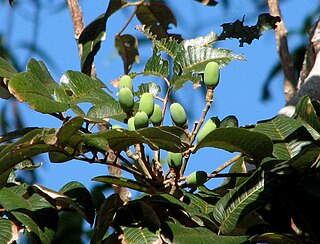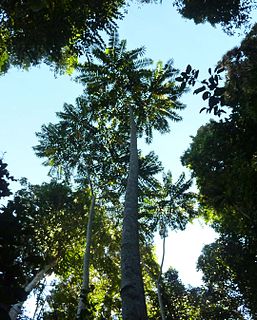Sankowskya is a genus of plants. The sole known species, Sankowskya stipularis, is a tree endemic to one locality in the Wet Tropics rainforests of northeastern Queensland, Australia. The species constitutes part of the plant family Picrodendraceae. Few botanical collections have ever been made of the trees, from a very restricted area of the Wet Tropics rainforests, hence the species has obtained the conservation status of "endangered" in the legislative regulation of the Queensland Government's Nature Conservation Act 1992. Notably, trees grow naturally in the Thylogale Nature Refuge.

Argyrodendron peralatum is a species of tree in the family Malvaceae. The trees are more commonly known as in the red tulip oak or red crowsfoot. They are endemic to northeastern Queensland, Australia between Tully and Cooktown. The most distinctive feature of Argyrodendron peralatum is that the trunks form large characteristic buttress roots.

Jagera is a genus of 4 species of forest trees known to science, constituting part of the plant family Sapindaceae.

Eupomatia laurina, commonly named bolwarra, native guava or copper laurel, is a species of plant in the primitive flowering-plant family Eupomatiaceae, endemic to Australia and New Guinea. It grows to between 3 and 5 m tall, but larger specimens may attain a height of 15 m (50 ft) and a trunk diameter of 30 cm (12 in). In Australia, it is found in humid forests of the east coast, from as far south as Nowa Nowa in Victoria, north through New South Wales and Queensland to tropical Cape York Peninsula. It usually grows as an understorey plant in rainforests or humid Eucalypt forests.

Canarium australianum is a species of trees, native to Australia and Papua New Guinea, of the plant family Burseraceae. Common names include mango bark, scrub turpentine, carrot wood, parsnip wood, Melville Island white beech and brown cudgerie.

Cryptocarya triplinervis is a rainforest tree growing in eastern Australia. Common names include the three veined laurel, three veined cryptocarya and the brown laurel.

Dysoxylum pettigrewianum, commonly known as spur mahogany, spurwood, or Cairns satinwood is a species of large tropical rainforest tree in the family Meliaceae found in Queensland, New Guinea, Solomon Islands and Malesia. In Queensland it is found in the wet tropics from Rossville near Cooktown in the north, southwards to Tully.

Karrabina biagiana is a species of large rainforest trees commonly known as northern brush mahogany, northern brush mararie or red carabeen, in the plant family Cunoniaceae. This species used to be placed in the genus Geissois as Geissois biagiana.

Ehretia saligna, commonly known as peach bush, native willow and peachwood is a species of shrubs or small trees, endemic to Northern Australia. The natural range extends from the Gascoyne, across the Northern Territory throughout northern Queensland and coastal; regions of Southern Queensland and New South Wales.
Hollandaea is a small genus of plants in the family Proteaceae containing four species of Australian rainforest trees. All four species are endemic to restricted areas of the Wet Tropics of northeast Queensland.

Eucryphia wilkiei is a species of rainforest shrubs endemic to restricted areas of cloud forests on mountain tops in the Wet Tropics region of northeastern Queensland, Australia. As of November 2013, botanists classify Eucryphia in the family Cunoniaceae.
Canarium australasicum, commonly named mango bark, brown cudgerie or parsnip wood, is a species of rainforest trees, of the plant family Burseraceae. They are endemic to Australia, in eastern Queensland and far northeastern New South Wales.

Mischarytera is a genus of rainforest trees, constituting part of the plant family Sapindaceae. Four species are known to science as of December 2013, found growing naturally in eastern Queensland, Australia, and in New Guinea. Formerly until 1995, they had names within the genus Arytera, subgenus Mischarytera.
Canarium muelleri, commonly named scrub turpentine or mangobark, is a species of Australian rainforest trees in the plant family Burseraceae. They are endemic to northeastern Queensland, widespread in the rainforests of the Wet Tropics region, and further south to the Conway Range area, near Proserpine, Queensland.
Eupomatia barbata, also named small bolwarra, is a species of small shrubs, of the Australian continent ancient plant family Eupomatiaceae.
Peripentadenia is a genus of two species of large trees from the family Elaeocarpaceae endemic to the rainforests of northeastern Queensland, Australia. Sometimes they have the common name quandong.
Lindsayomyrtus is a monotypic genus in the family Myrtaceae, containling the single species Lindsayomyrtus racemoides, commonly known as Daintree penda. These large trees grow naturally in the rainforests of the Wet Tropics of Queensland in Australia, the Moluccas, New Guinea and New Britain.

Dysoxylum gaudichaudianum is a species of plant in the family Meliaceae; its common name is ivory mahogany. "Igyo" is its native name in the Philippines.
Syzygium forte, commonly known as white apple, flaky-barked satinash or brown satinash, is a tree of the family Myrtaceae native to Western Australia, the Northern Territory, Queensland and New Guinea.
Syzygium kuranda, commonly known as cherry penda, cherry satinash or kuranda satinash, is a tree of the family myrtaceae native to north eastern Queensland.














